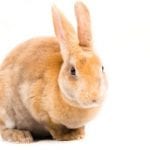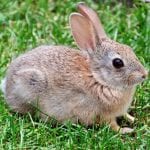Scientific Facts
| Common Name: | Thrianta Rabbit |
| Scientific Name: | – |
| Life Span: | 7 to 10 years |
| Size: | 4 to 6 pounds |
| Habitat: | Domesticated |
| Country of Origin: | Thrianta, Netherlands |
Thrianta Rabbit Information
The Thrianta Rabbit is a domesticated breed of rabbit that can trace its origins back in Holland. It was there when a rabbit breeder by the name of H. Andreae wished to breed a rabbit that he would name in honor of the royal House of Orange. He did so by crossbreeding different kinds of domesticated rabbits, including Havana and the Tortoise Papillon. The result was the rabbit he eventually named after his hometown of Thrianta. It became a popular breed of rabbit and soon gained recognition as an official rabbit breed in the Netherlands just before World War II struck.
However, during the Second Great War, many of these rabbit species were lost as a result of the shortage of meat and other sources of protein. Rabbit meat became one of the main food sources at a time when there was scarcity in almost all kinds of resources. To that end, the Thrianta rabbit was one of the rabbit breeds that were used as a source of food. The war almost wiped out the entire population of these rabbits.
Luckily, some Thrianta Rabbits were able to survive the war and were kept and preserved by prominent rabbit breeders. The original Thrianta Rabbit became genetically different from the ones we see today as the breeders of yesteryears bred the few remaining true Thriantas with German rabbits in an attempt to preserve the breed. The new generation of Thrianta Rabbits was eventually brought over to the United States during the 90s and, a decade later, gained recognition from the American Rabbit Breeders Association. Decades after it had almost gone extinct, the Thrianta Rabbit is now one of the more popular breeds of domesticated rabbits all over America and is only continuing to grow in numbers and in overall fame.
Physical Description
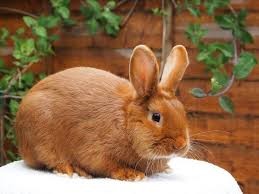
Thrianta Rabbits are medium-sized breeds of domesticated rabbits that share a lot of common similarities with the rabbits that were bred in many different places in Europe. It can be as heavy as about 4 to 6 pounds and is not the heaviest type of rabbit due to how it does not seem like it is quite as big as the other breeds that are very popular in America. Compared to the stout and long American-bred rabbits, this European breed has a body that is quite compact and proportional to its overall length, weight, and body build.
Despite how compact its body structure is, you can clearly notice the round shape that the Thrianta Rabbit comes in. Like most other breeds of rabbits that originated in Europe, this one is round all over and has an appearance that can be quite stout and plump to the point that it may look a bit fat even though it is not quite the biggest or heaviest rabbit out there.
The Thrianta Rabbit has a strikingly short head, which is a feature that is quite unique to it. However, despite how short its head is, the shape is fully rounded and looks proportional to the rest of its round and compact body. Meanwhile, the neck is also pretty short and matches the overall short length of the rabbit’s head. Nevertheless, the neck should be erect and should not make the rabbit look like its head is just hanging out there.
A Thrianta Rabbit should have fur that is quite thick. Its coat is quite dense, and it gives the rabbit a cuddly appearance. The hairs on the fur should be rolled back and is more or less on the medium size of things in terms of length. The fur should be very soft to the touch while you are simply petting or stroking the rabbit’s hair. Because of this, it can be quite important to note that you should regularly groom the rabbit as its thick and long hair can matt in the future if not taken care of properly.
One of the more unique physical attributes descriptive of the Thrianta rabbit is that it has only one officially ARBA-recognized color. Some may claim that they have Thriantas that come in all sorts of other colors, but there really is only one color that is recognized by the ARBA. Thrianta Rabbits should have the striking signature fiery brown color that has made it one of the most adored rabbits all over America. Any color other than that will only indicate that the rabbit is not a pure Thrianta or that it isn’t even a Thrianta at all in the first place.
Aside from the fact that there is only one official color, the Thrianta Rabbit should have a shade that is uniform all over its body. There should be no other visible markings on the rabbit’s coat whatsoever. This makes it a unique breed on its own as plenty of rabbit breeds come in only one color but still have other markings that would break the monotony of their color schemes.
Personality
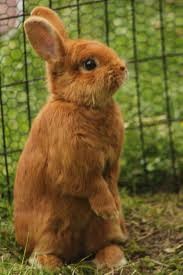
Given the fact that the original Thrianta Rabbit breed came about as the result of the crossbreeding between many different European rabbit breeds, it only is expected that it comes with a personality that is quite the same as its other European rabbit cousins and relatives. What that means is that the Thrianta has the friendly, gentle, mild-mannered, and affectionately sweet personality and demeanor that is common in most domesticated breeds of European rabbits. In that regard, this rabbit should be a very good companion for anyone who wants a pet that behaves in a way that a pet should. It is generally good-natured and will always make you feel like you are well-loved.
The good thing about the Thrianta Rabbit is that, even though it is one of the more affectionate rabbit breeds around, it does not have the demanding personality that some of the other breeds come with. This friendly bunny will try to stay sweet towards you even though you are not giving it your full attention. That said, it does not require a lot of effort on your part for it to stay happy and affectionate. You will love the fact that you do not have to always cuddle with it or show your affection towards it due to how it has an unselfish personality when it comes to how it gives love and affection.
Not the most playful type of rabbit, the Thrianta Rabbit, makes for a good pet for small children and older adults due to how it will not require you to play with it on a regular basis for it to stay happy. Nevertheless, it can also show a playful side when you actually try to play with it. As such, this rabbit is a pretty good pet for children as this breed comes in a manageable size that also makes it a good pet for kids. And, on top of that, your kids will also love how it is not too fragile to the point that the simplest playtime moments will cause injury.
Due to how it is not the most playful type of rabbit, the Thrianta Rabbit also is not the liveliest or most active breed. When you are not trying to play with it, it will most likely prefer to stay in place to cuddle with you. Other than that, it might be curious enough to explore its surroundings, but it generally is not too active or too lively to the point that it will run and hop around the room uncontrollably.
Life Span
Thrianta Rabbits are really similar to their other European counterparts because of how they are some of the most resilient pet rabbits to have. They are hardy and very resistant to a lot of diseases and conditions that can very well affect how long they get to live. As such, at the minimum and when given enough care, the Thrianta Rabbit will get to live 5 or so years. However, if you give it the best kind of care possible and if you have yourself a rabbit that is naturally healthier than other Thriantas, it may be able to live for about 10 or so years.
When it comes to its health, the Thrianta Rabbit suffers from all of the other common problems that most other rabbits suffer from. It is prone to digestive problems due to its short to moderately-long coat. Aside from that, it will also face dental problems because of how its teeth will never stop growing. As long as you know the best way to correct those problems, the Thrianta Rabbit generally is not very problematic to have as far as its health is concerned.
Thrianta Rabbits and even rabbits, in general, do not like getting bathed. Getting them wet when you try to bathe them can easily get them stressed. When a rabbit gets stressed out, its health will eventually deteriorate. At times, something as simple as bathing the rabbit can cause it to die. As such, if you want to make sure that your Thrianta Rabbit gets to live a long lifespan, never bathe it. Instead, spot clean it or take it to a professional groomer if you think it has gotten dirtier than usual.
Reproduction
Thrianta Rabbits follow the same reproductive pattern as any other domesticated rabbit because, at the end of the day, they all have the same roots. This rabbit will be able to give multiple times in a single year and can be sexually active all year long so long as it has already reached sexual maturity (somewhere between the ages of 4 to 6 months old). Most Thrianta Rabbits will give birth to a litter size of about 5 to 7 rabbits, but it can be as few as 1 or 2 baby bunnies depending on the conditions and on how many times they have already given birth.
Behavior
Thrianta Rabbits make great pets for any kind of household due to the fact that they are generally rabbits that are quite well-behaved and good-natured. As friendly as this breed may be, it is not known to do anything that is out of the normal or acts that can be a bit troublesome for its owner. In that sense, it really is not the most troublesome rabbit as far as its overall behavior is concerned.
As friendly as it is, the Thrianta Rabbit will most probably try to stay close to its owner as much as it can. It loves to act sweet towards its family and prefers to show its affectionate side whenever possible. But the good thing about this very affectionate rabbit is that it does not seem to demand as much attention from you as other friendly rabbits do. It may show a one-sided kind of sweetness, but that does not mean that you should disregard its affection. As much as possible, try reciprocating its sweetness by cuddling with it or by giving it some attention. You can even try to play with it if you can.
Speaking of play, the Thrianta Rabbit may not be the most playful rabbit due to how it really is not too active and lively; it might try to play with you if you coax it. Nevertheless, you will find that playtime with this rabbit is not the most exciting part of spending time with it due to how it lacks the liveliness of other breeds. But, even though it is not the liveliest or most active type of pet rabbit, the Thrianta Rabbit is a joy to have because its well-behaved personality allows it to be an easy pet to take care of for those who simply want companionship.
The Thrianta Rabbit can be a bit more docile than other rabbit breeds. This makes it easy for you to handle it or to cuddle with it as it does not tend to show its skittish side. Guests also will not find it very difficult to handle this kind of a rabbit actually easily submits itself to human care as long as handling it is done in a careful and controlled way that allows the rabbit to feel safe.
Litter training your Thrianta Rabbit might not be the easiest thing to do since this breed is not known to be easy to train. However, you can still find yourself successful in this regard if you try hard enough, and if you know how to coax them with some treats. At times, there will be some instances when you might need to use multiple litter boxes around the room or in the house to make sure that it gets used to using a litter box when nature is calling.
Eating Habits
Thrianta Rabbits are generally very similar to any kind of domesticated rabbit when it comes to their overall diet. If you have one with you, make sure that it follows a grass and plant-based diet because of its nature as an herbivore. However, the important part here is that it should be given a diet that is based primarily on hay. In case you do not know, hay has a lot of fiber and takes time for the rabbit to chew. The fiber in hay aids the rabbit’s digestive problems. Meanwhile, the constant chewing that the Thrianta Rabbit will be doing aids its dental health and keeps the length of its teeth in check. Hay should comprise about 70% of the Thrianta Rabbit’s overall diet.
Because hay does not have a complete nutritional profile, there is a need to supplement the Thrianta Rabbit’s diet with fruits and vegetables that provide it with vitamins and nutrients that it cannot get from hay. Make sure to feed it with leafy green vegetables that are low in starch. Meanwhile, when feeding it with fruits, make it a point to trim down on fruits that are high in sugar. Fruits should be an occasional treat. Rabbit pellets may also be good for supplementing the Thrianta Rabbit’s overall diet. These pellets were commercially formulated to contain some of the necessary nutrients that domesticated rabbits need. That said, try to keep vegetable intake somewhere around 15% to 20% of the Thrianta Rabbit’s overall daily calorie intake. The rest can be divided between fruits and pellets.
Water
While the Thrianta Rabbit is not known to be quite the active pet, that does not mean that you should skimp out on the water. Hydration will always be more important than food. Rabbits may be able to go a few days without food, but they will eventually die in a matter of a couple of days if they do not drink water. That said, make sure to keep a clean dish with fresh water in the rabbit’s cage. Always see to it that you change the water whenever it gets contaminated to avoid exposing the Thrianta Rabbit to any kind of water-borne disease or infection.
Cage
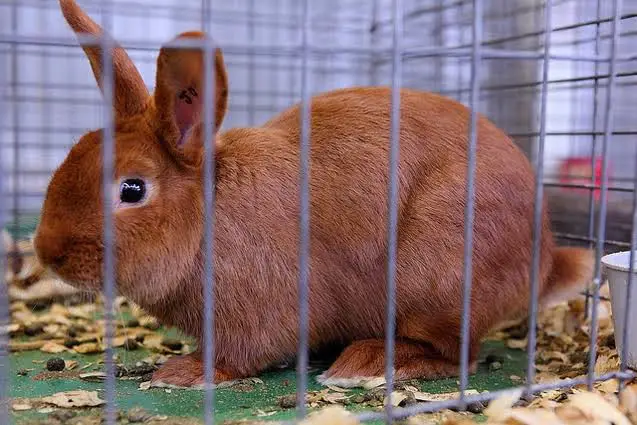
Thrianta Rabbits ore any kind of domesticated rabbit can do well by simply living in any kind of commercially sold rabbit cage that was made to be used specifically by rabbits. That means that you will not find it a very difficult task to house your rabbit as it generally accepts life in a rabbit cage very easily.
Outdoor enclosures may be a good idea for the Thrianta Rabbit because it allows it the room it may need to stretch its legs and move around. There is also plenty of fresh air and sunlight outdoors. However, not all outdoor environments are suitable for this rabbit. If you want to house yours outdoors, make sure that the climate is fit for the rabbit and that there are no predators large enough to prey on it. Parasites and other types of infections are also more common outdoors.
To keep things on the safe side, house your Thrianta Rabbit indoors. The cage should be about 4 to 5 times the size of the rabbit to give it enough space to move around and stretch its legs. However, because this breed is not too active, you do not have to house it in a cage that is more than 5 to 6 times bigger than it. Making sure that the cage is not too cramped will be enough for the Thrianta Rabbit. Just give it some time outside of its cage if you want it to have it moving and running around for a good exercise session.
Thrianta Rabbits are not very playful. That means that there is no need for you to provide it with toys inside its enclosure. But if you want to foster its playful side, you can place toys inside its enclosure, although there is no guarantee that it will play with them. It might be better for you to have it play outside its enclosure if you really want to encourage your Thrianta Rabbit’s playful side.
Availability – Where to Get one
A Thrianta Rabbit can be purchased for a price that is somewhere close to $35 to $50 depending on the breeder and on the region where you got it. It is not a very rare rabbit and has become quite popular ever since its introduction to the American market back in the 1990s. It is also ARBA-recognized. In that sense, always make sure that you get a rabbit that follows ARBA standards and that you get your Thrianta from a breeder that is quite reputable but not too expensive for your budget. The Thrianta Rabbit only comes in one color, which is the fiery orange or brownish color scheme. In that regard, make sure that yours follows the only color recognized by the ARBA.
How to Care for a Thrianta Rabbit
Thrianta Rabbits are known to be the ideal pets to have because they are not the most demanding and most difficult animals to take care of. These rabbits are quite receptive to human care and handling and will not require you to spend a lot of time, attention, and effort into taking care of it. That makes the Thrianta a joy to have around in your household as it is not only easy to take care of but also is a very happy pet to have due to its friendly personality.
Their diet is one of the more important things to take note of when taking care of Thrianta Rabbits. A rabbit of this kind is susceptible to digestive and dental problems. However, by simply following a diet that is about 70% of hay can solve a lot of its health problems. The fiber in hay and the difficulty in chewing it will resolve most digestive and dental problems that plague Thrianta Rabbits.
Also, you should also take note that the Thrianta Rabbit does well both outdoors and indoors. Outdoor enclosures made out of wood and metal wire for fencing will be enough for it. On top of that, your rabbit will be able to get a lot of fresh air and sunlight by spending time outdoors. However, outdoor environments are not the safest in terms of their health and welfare. So, in that regard, you might want to invest in an indoor enclosure instead if you really want to keep your rabbit safe and secured from all of the harmful diseases and conditions that can be found outdoors.
FAQs
Are Thrianta Rabbits ideal pets?
It has always been said that the Thrianta Rabbit is one of the better pet rabbits to have for a household due to its sweet demeanor and generally friendly personality.
Are Thrianta Rabbits active pets?
Thrianta Rabbits are known to be pets that are not too active and lively and are almost always calm and well-behaved.
For what purpose was the Thrianta Rabbit bred for?
Thrianta Rabbits were originally bred in honor of the royal House of Orange in the Netherlands but were quickly becoming a good source of meat during World War II.
What is the best way to interact with a Thrianta Rabbit?
Just being around it will be enough for your Thrianta Rabbit. But if you really want to interact with it, you can try to handle it as this rabbit is generally very receptive to getting handled.
Do Thrianta Rabbits like getting handled?
Thrianta Rabbits are docile animals that will accept handling very easy.
Can I bathe my Thrianta Rabbits?
Thrianta Rabbits and any other kind of rabbit, in general, do not like getting bathed because it stresses them out. Instead, spot-cleaning them or taking them to a professional groomer is the best way to keep them clean.
Is the Thrianta Rabbit recognized by the ARBA?
The Thrianta Rabbit got is official ARBA recognition during the middle of the 2000s and has since become one of the more popular breeds in all of America.
What are the colors of the Thrianta Rabbit?
While the Thrianta Rabbit may come in a lot of different colors, the ARBA only recognizes the fiery orange color as the only color scheme for this breed.
